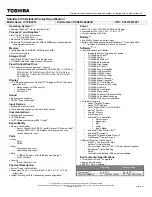
Part III: Appendixes
Glossary
244
enable:
To turn on a computer option.
erase:
See
delete
.
error-correcting code:
Code designed for transmission of electronic data,
that encodes data in such a way that transmission errors may be
detected and corrected by examination of the encoded data on the
receiving end. Error-correcting code is used in most modems and in
some RAM. In the latter case, circuitry is used that generates
checksums to correct errors greater than one bit.
escape:
1) To cancel the task currently in progress. 2) A code (ASCII
code 27, generated by the ESC key) telling the computer that what
follows are commands, not data. Used with peripheral devices such
as printers and modems.
execute:
1) To run a program or macro. 2) To interpret and carry out an
instruction in a computer program.
executable file:
A computer program that is ready to run. Application
programs and batch files are examples of executable files. Names of
executable files usually end with a .BAT, .COM or .EXE extension.
expanded memory:
Memory that occupies part of the area between 640
KB (the end of base memory) and 1 MB. This memory is used
according to the standard developed jointly by Lotus, Intel, and
Microsoft (LIM), known as the Expanded Memory Specification
(EMS). The abbreviation LIM-EMS refers to this standard.
extended memory:
Memory beyond 1MB. Windows 95 and NT, OS/2
and some MS-DOS programs use extended memory.
extension:
See
filename extension
.
external device:
Any device connected to a port on your computer.
Examples of external devices are printers, tape backup units, and
external modems.
F
file:
A collection of related information, saved on disk with a unique
name (such as the information required for a program or document).
file allocation table (FAT):
The section of a disk that keeps track of the
location of files stored on the disk.
Summary of Contents for 8000 series
Page 21: ...xxi ...
Page 22: ......
Page 43: ...Part I Getting to Know Your Computer To Begin When and how to turn off the computer 19 ...
Page 107: ...Part I Getting to Know Your Computer Using Drives Playing a DVD video 83 ...
Page 174: ......
Page 176: ...Chapter Using TSETUP 153 Using Hardware Setup 154 ...
Page 210: ...Chapter Industry standard architecture 187 System management 189 Security management 196 ...
Page 224: ......
Page 226: ...Appendix Built in features 203 Optional accessories and devices 211 Specifications 214 ...
Page 239: ...Part III Appendixes Features and Specifications 215 ...
Page 240: ...Appendix ...
Page 249: ...Part III Appendixes System Resources 225 ...
Page 250: ...Appendix ...
















































